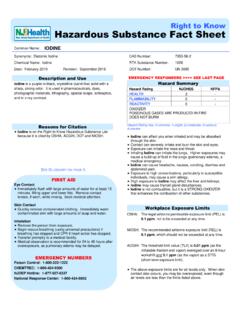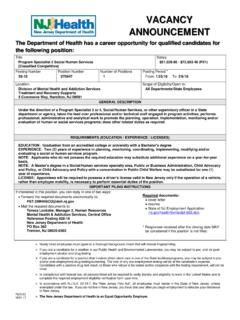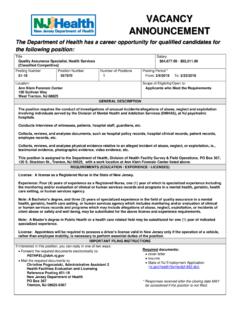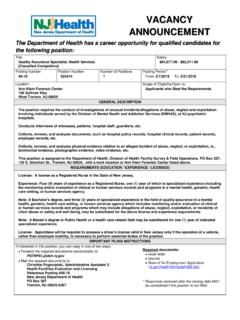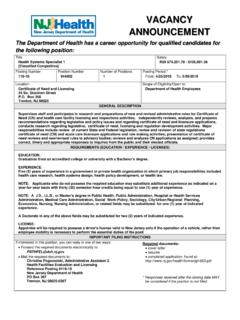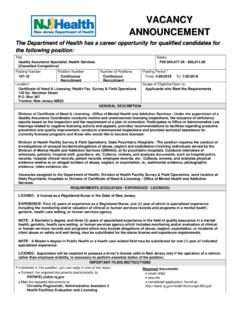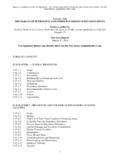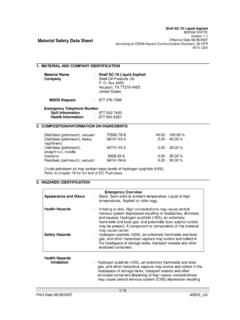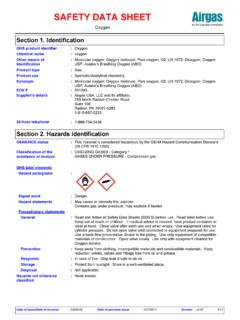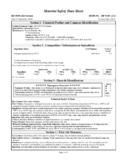Transcription of ASPHALT HAZARD SUMMARY HOW TO DETERMINE IF …
1 Common Name: ASPHALT CAS Number: 8052-42-4 DOT Number: NA 1999 ( ASPHALT ) UN 1999 (Tars, Liquid) DOT HAZARD Class: 3 (Flammable) ---------------------------------------- --------------------------------- HAZARD SUMMARY * ASPHALT can affect you when breathed in. * Extracts of certain Asphalts have been shown to cause cancer in animals. * ASPHALT fumes can irritate the eyes on contact. * Breathing ASPHALT fumes can irritate the nose, throat and lungs causing coughing, wheezing and/or shortness of breath. * Contact can irritate and cause severe burns of the skin and may cause dermatitis and acne-like lesions.
2 * Exposure to ASPHALT fumes can cause headache, dizziness, nausea and vomiting. * Long-term contact can cause skin pigment change which is made worse by sunlight exposure. * Cutback and Rapid Curing ASPHALT are FLAMMABLE and FIRE hazards . * ASPHALT is derived from Petroleum. ASPHALT and Coal Tar Pitch are different. If you are actually working with Coal Tar chemicals, CONSULT THE NEW JERSEY DEPARTMENT OF HEALTH AND SENIOR SERVICES HAZARDOUS SUBSTANCE FACT SHEETS ON COAL TAR PITCH AND COAL TARS. * ASPHALT , Oxidized (CAS # 64762-93-4) is a carcinogen. CONSULT THE NEW JERSEY DEPARTMENT OF HEALTH AND SENIOR SERVICES HAZARDOUS SUBSTANCE FACT SHEET ON ASPHALT , OXIDIZED.
3 IDENTIFICATION ASPHALT is a blackish-brown solid, semi-solid or liquid, depending on the formulation or mixture of ASPHALT used. ASPHALT fumes are produced during the manufacture and heating of ASPHALT , which is used for road building and roofing, and in rubber and adhesives. REASON FOR CITATION * ASPHALT is on the Hazardous Substance List because it is cited by ACGIH, DOT, NIOSH, IARC and NFPA. * Definitions are provided on page 5. RTK Substance number: 0170 Date: January 2001 Revision: April 2007 ---------------------------------------- --------------------------------- HOW TO DETERMINE IF YOU ARE BEING EXPOSED The New Jersey Right to Know Act requires most employers to label chemicals in the workplace and requires public employers to provide their employees with information and training concerning chemical hazards and controls.
4 The federal OSHA HAZARD Communication Standard (29 CFR ) requires private employers to provide similar training and information to their employees. * Exposure to hazardous substances should be routinely evaluated. This may include collecting personal and area air samples. You can obtain copies of sampling results from your employer. You have a legal right to this information under the OSHA Access to Employee Exposure and Medical Records Standard (29 CFR ). * If you think you are experiencing any work-related health problems, see a doctor trained to recognize occupational diseases.
5 Take this Fact Sheet with you. WORKPLACE EXPOSURE LIMITS NIOSH: The recommended airborne exposure limit is 5 mg/m3, which should not be exceeded during any 15-minute period. ACGIH: The recommended airborne exposure limit is mg/m3 (for the inhalable fraction of the Benzene-soluble aerosol), averaged over an 8-hour workshift. WAYS OF REDUCING EXPOSURE * Where possible, enclose operations and use local exhaust ventilation at the site of chemical release. If local exhaust ventilation or enclosure is not used, respirators should be worn. * Wear protective work clothing.
6 * Wash thoroughly immediately after exposure to ASPHALT and at the end of the workshift. * Post HAZARD and warning information in the work area. In addition, as part of an ongoing education and training effort, communicate all information on the health and safety hazards of ASPHALT to potentially exposed workers. ASPHALT page 2 of 6 This Fact Sheet is a SUMMARY source of information of all potential and most severe health hazards that may result from exposure. Duration of exposure, concentration of the substance and other factors will affect your susceptibility to any of the potential effects described below.
7 ---------------------------------------- ---------------------------------- HEALTH HAZARD INFORMATION Acute Health Effects The following acute (short-term) health effects may occur immediately or shortly after exposure to ASPHALT : * ASPHALT fumes can irritate the eyes on contact. * Breathing ASPHALT fumes can irritate the nose, throat and lungs causing coughing, wheezing and/or shortness of breath. * Contact can irritate and cause severe burns of the skin and may cause dermatitis and acne-like lesions. * Exposure to ASPHALT fumes can cause headache, dizziness, nausea and vomiting.
8 Chronic Health Effects The following chronic (long-term) health effects can occur at some time after exposure to ASPHALT and can last for months or years: Cancer HAZARD * While ASPHALT has not been identified as a carcinogen, it should be HANDLED WITH CAUTION since extracts of certain Asphalts have been shown to cause cancer in animals. Reproductive HAZARD * According to the information presently available to the New Jersey Department of Health and Senior Services, ASPHALT has not been tested for its ability to affect reproduction. Other Long-Term Effects * Long-term contact can cause skin pigment change which is made worse by sunlight exposure.
9 * ASPHALT fumes can irritate the lungs. Repeated exposure may cause bronchitis to develop with cough, phlegm, and/or shortness of breath. MEDICAL Medical Testing Before beginning employment and at regular times after that, for those with frequent or potentially high exposures, the following are recommended: * Lung function tests Any evaluation should include a careful history of past and present symptoms with an exam. Medical tests that look for damage already done are not a substitute for controlling exposure. Request copies of your medical testing.
10 You have a legal right to this information under the OSHA Access to Employee Exposure and Medical Records Standard (29 CFR ). Mixed Exposures * Because smoking can cause heart disease, as well as lung cancer, emphysema, and other respiratory problems, it may worsen respiratory conditions caused by chemical exposure. Even if you have smoked for a long time, stopping now will reduce your risk of developing health problems. Conditions Made Worse By Exposure * Exposure to sunlight may make skin effects of ASPHALT worse. WORKPLACE CONTROLS AND PRACTICES Unless a less toxic chemical can be substituted for a hazardous substance, ENGINEERING CONTROLS are the most effective way of reducing exposure.



